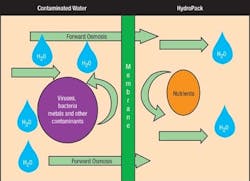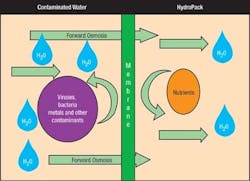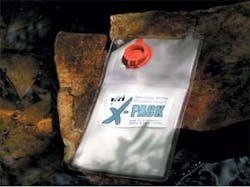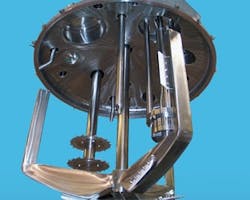Membrane makes it possible
Many filtration and purification technologies are available today, but virtually all of them suffer from a familiar set of disadvantages. Most require energy and mechanical parts to force liquid through a filter -- and energy is often in short supply during a crisis. Many such systems are complex and demand special training. Others require components that are delicate, not designed for rugged use, or too heavy to be considered portable.
Virtually all mechanical filters capture impurities and eventually clog. Ultrafine filters -- those that are designed to reject pathogens and extremely small impurities -- clog quickly when filtering turbid water.
One alternative to mechanical filtration is chemical purification. But chemical treatments require precise dosages and exposure times, and can leave an unpleasant taste. They are also ineffective against threats such as chemical poisons, heavy metals and even some microorganisms. Another critical disadvantage is that many chemical treatments are ineffective at purifying water that is extremely cloudy or turbid.
The one filtration concept that is free of all of these disadvantages is forward osmosis (FO). (See sidebar: &ldquoForward Osmosis: How it Works.&rdquo)
&ldquoThe forward-osmosis concept has been around for years,&rdquo says Robert Salter, CEO of HTI. &ldquoIn theory, it looked like the perfect alternative to energy-reliant technologies -- mainly because it is so simple.&rdquo
In Hydration Technology&rsquos FO filtration system, water diffuses into the bag when a generic sport-drink powder is in contact with the inner, clean side of the membrane. The process is spontaneous. It requires no energy, no moving parts and no special expertise. It won&rsquot clog in even the most turbid water (up to 1,000 Nephelometric Turbidity Units), because dirty water is not being driven by hydraulic pressure into the filter material. Instead, clean water is being drawn through the filter osmotically.
Keith Lampi, cofounder and COO for HTI, says, &ldquoThe FO concept was elegant, but the key to making an FO filter work was the membrane. FO filtration was a terrific idea, but it just wasn&rsquot practical until we discovered how to create a hydrophilic membrane that works efficiently. With previous membrane materials developed by our researchers and many others, water diffused too slowly into the bag.&rdquo
Lampi adds, &ldquoAnother critical issue is the consistency of the membrane and the size of the pores that reject impurities. Filtering out dirt particles and other large impurities is easy. Our goal was to develop a membrane that would reliably reject the impurities that present the most serious threats, including bacteria, viruses and common microorganisms.&rdquo
Triple-shaft mixer to the rescue
After a long development effort, the HTI team was close to success, but needed a mixer that could create the membrane material and meet consistency and cost-efficiency goals. The multistep process first requires aggressive cellulose grinding, followed by continued dispersion and dissolution as numerous other ingredients are added to a casting solution.
&ldquoWe knew that a single-shaft mixer -- even one equipped with multiple disperser blades -- could not handle the job. So, my first impulse was to test a dual-shaft mixer,&rdquo says Steve Peterson, P.E., and senior project engineer for HTI. &ldquoIn my experience, I have found that dual-shaft mixers are generally fast, versatile and cost-efficient.&rdquo
But in this case, tests using a conventional dual-shaft mixer in an open vessel produced unsatisfactory results. The process took six hours to produce an inadequate final dispersion. Looking for an alternative, the HTI engineering team scheduled a test at the Ross Test & Development Center in Hauppauge, N.Y.
After shipping raw materials to the lab, the HTI team simulated their process on a Ross VersaMix, a triple-shaft mixer that combines a slow-speed anchor agitator with a high-speed disperser and a rotor/stator high-shear mixer.
The HTI membrane is a rugged composite. An ultrathin (10 µ) FO layer is sandwiched with a microfilter and a fabric backing, which provides strength. With pores measuring 5 à (0.0005 µ) in diameter, the FO layer successfully filters E. coli bacteria, anthrax spores, viruses, heavy metals, suspended particles and other health threats.
Forward osmosis is normally a very slow process since it is not driven by hydraulic pressure. The HTI membrane allows water to pass at a much higher rate (as high as 1 L/hr in some of the personal hydration systems) because the FO layer is so thin. Also, since it is made from cotton-derived, cellulose-ester plastics, the FO layer is extremely hydrophilic. This allows water to pass through easily, accelerating the filtration process.
Hydration Technologies&rsquo X-Pack is the first FO filter to be commercialized. The success of the membrane is due to the combination of ultra-small and highly consistent porosity with a high pass-through rate.
The Ross VersaMix is a triple-shaft mixer that includes a slow-speed anchor agitator and two high-speed devices: a rotor/stator high-shear mixer and a high-speed disperser (Figure 3). The anchor sweeps the vessel wall and bottom, constantly removing material that would otherwise impede heat transfer. As it turns, it also stimulates radial and axial mass flow to promote thorough batch turnover.
The rotor/stator high-shear mixer applies intense shear and generates moderate flow. The high-speed disperser, shown here with a sawtooth blade, applies moderate shear and generates substantially greater flow. All three agitators are independently controlled with electronic variable-speed drives and monitored with instrumentation.
For demanding applications, the triple-shaft mixer offers a broad range of capabilities. This includes the ability to apply extremely intense shear with the rotor/stator mixer, while maintaining vigorous flow with the other two agitators.
With independent controls, the two high-speed agitators are often used selectively during a series of mixing phases. This allows the operator to choose the right combination of agitators and tip speeds for each phase, depending on key process variables, such as shear requirements, heat thresholds and batch viscosity.
The triple-shaft mixer quickly breaks down the cellulose acetate polymer and disperses it into the casting solution, along with the other ingredients.The rotor/stator mixer is especially well-suited for the first phase of the HTI application. The process takes a long time in a dual-shaft mixer because polymer pellets bounce off the teeth of a high-speed disperser blade. The rotor/stator mixer, on the other hand, draws them into the high-shear zone and doesn&rsquot let them escape until they are broken apart. Meanwhile, the disperser and anchor agitators maintain energetic flow, which ensures a high degree of batch homogeneity.Also vital to the HTI application, vigorous flow helps carry heat away from the high-shear zone and disperse it evenly throughout the vessel. This helps protect the heat-sensitive polymer while allowing for an increased shear rate.The rotor/stator mixer can be fitted with a variety of stators, which provides a great deal of flexibility in matching the mixer configuration to the application (April, p. 31).&ldquoWith a dual-shaft mixer, the initial phase produced âgel balls&rsquo that resisted wetting out and dispersion,&rdquo Peterson says. &ldquoBut with the triple-shaft mixer -- thanks to the intense shear that the rotor/stator mixer applies -- the gel balls dissipate very quickly. At that point in the cycle, we turn off the high-shear mixer and proceed with only the high-speed disperser and the anchor agitator.&rdquo The batch was complete in two hours, compared with the six-hour cycle that a dual-shaft mixer required.Today, HTI operates with a 40-gal. VersaMix in full-scale production, while a 2-gal. model supports a vigorous R&D program. Anticipating the need for multiple process lines before long, the company plans to follow up its success on the battlefield with applications in other industries, including homeland security, international relief and development, and the maritime industries.
Doug Cohen is vice president of technical services for Charles Ross & Son Co., Hauppauge, N.Y. E-mail him at [email protected].



